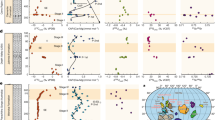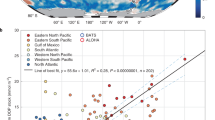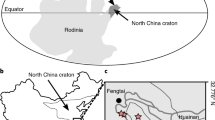Abstract
Despite similar physical properties, the Northern and Southern Atlantic subtropical gyres have different biogeochemical regimes. The Northern subtropical gyre, which is subject to iron deposition from Saharan dust1, is depleted in the nutrient phosphate, possibly as a result of iron-enhanced nitrogen fixation2. Although phosphate depleted, rates of carbon fixation in the euphotic zone of the North Atlantic subtropical gyre are comparable to those of the South Atlantic subtropical gyre3, which is not phosphate limited. Here we use the activity of the phosphorus-specific enzyme alkaline phosphatase to show potentially enhanced utilization of dissolved organic phosphorus occurring over much of the North Atlantic subtropical gyre. We find that during the boreal spring up to 30% of primary production in the North Atlantic gyre is supported by dissolved organic phosphorus. Our diagnostics and composite map of the surface distribution of dissolved organic phosphorus in the subtropical Atlantic Ocean reveal shorter residence times in the North Atlantic gyre than the South Atlantic gyre. We interpret the asymmetry of dissolved organic phosphorus cycling in the two gyres as a consequence of enhanced nitrogen fixation in the North Atlantic Ocean4, which forces the system towards phosphorus limitation. We suggest that dissolved organic phosphorus utilization may contribute to primary production in other phosphorus-limited ocean settings as well.
This is a preview of subscription content, access via your institution
Access options
Subscribe to this journal
Receive 12 print issues and online access
$259.00 per year
only $21.58 per issue
Buy this article
- Purchase on Springer Link
- Instant access to full article PDF
Prices may be subject to local taxes which are calculated during checkout



Similar content being viewed by others
References
Duce, R. A. & Tindale, N. W. Atmospheric transport of iron and its deposition in the ocean. Limnol. Oceanogr. 36, 1715–1726 (1999).
Wu, J., Sunda, W., Boyle, E. A. & Karl, D. M. Phosphate depletion in the Western Atlantic Ocean. Science 289, 759–762 (2000).
Poulton, A. J. et al. Phytoplankton carbon fixation, chlorophyll-biomass and diagnostic pigments in the Atlantic Ocean. Deep-Sea Res. II 53, 1593–1610 (2006).
Reynolds, S. E. et al. How widespread and important is N2 fixation in the North Atlantic Ocean? Glob. Biogeochem. Cycles 21, GB4015 (2007).
Williams, R. G. & Follows, M. J. in Ocean Biogeochemistry: The Role of the Ocean Carbon Cycle in Global Change (ed. Fasham, M.) (Springer, Berlin, 2003).
Redfield, A. C. in On The Proportions of Organic Derivatives in Seawater and their Relation to the Composition of Plankton (ed. Daniel, R. J.) (Univ. Press of Liverpool, Liverpool, 1934).
Tyrell, T. The relative influences of nitrogen and phosphorus on oceanic primary production. Nature 400, 525–531 (1999).
Beardall, J., Young, E. & Roberts, S. Approaches for determining phytoplankton nutrient limitation. Aquat. Sci. 63, 44–69 (2001).
Hoppe, H.-G. in Handbook of Methods in Aquatic Microbial Ecology (eds Kemp, P., Sherr, B., Sherr, E. & Cole, J. J.) 423–431 (Lewis Publishers, Boca Raton, FL, 1993).
McGillicuddy, D. J. Jr & Robinson, A. R. Eddy-induced nutrient supply and new production in the Sargasso Sea. Deep-Sea Res. I 44, 1427–1450 (1997).
Carlson, C. A. in Biogeochemistry of Marine Dissolved Organic Matter (eds Hansell, D. A. & Carlson, C. A.) 91–151 (Academic, London, 2002).
Karl, D. M. & Byorkman, K. M. in Biogeochemistry of Marine Dissolved Organic Matter (eds Hansell, D. A. & Carlson, C. A.) 249–367 (Academic, London, 2002).
Li, W. K. W. Consideration of errors in estimating kinetic-parameters based on Michaelis–Menten formalism in microbial ecology. Limnol. Oceanogr. 28, 185–190 (1983).
Roussenov, V., Williams, R. G., Mahaffey, C. & Wolff, G. A. Does the transport of dissolved organic nutrients affect export production in the Atlantic Ocean? Glob. Biogeochem. Cycles 20, GB3002 (2006).
Jenkins, W. J. H-3 and He-3 in the beta-triangle—observations of gyre ventilation and oxygen utilization rates. J. Phys. Oceanogr. 17, 763–783 (1987).
Tyrrell, T. et al. Large-scale latitudinal distribution of Trichodesmium spp. in the Atlantic Ocean. J. Plankton Res. 25, 405–416 (2003).
Dyhrman, S. T. et al. Phosphonate utilization by the globally important marine diazotroph Trichodesmium. Nature 439, 68–71 (2006).
Sohm, J. A. & Capone, D. G. Phosphorus dynamics of the tropical and subtropical North Atlantic: Trichodesmium spp. versus bulk plankton. Mar. Ecol. Prog. Ser. 317, 21–28 (2006).
Hurrell, J. W. in The North Atlantic Oscillation: Climate Significance and Environmental Impact (eds Kushnir, Y., Ottersen, G. & Visbeck, M.) (American Geophysical Union, Washington, DC, 2003).
Emerson, S. et al. Experimental determination of the organic carbon flux from open-ocean surface waters. Nature 389, 951–954 (1997).
Thingstad, T. F. et al. Nature of phosphorus limitation in the ultraoligotrophic eastern Mediterranean. Science 309, 1068–1071 (2005).
Karl, D. M., Bidigare, R. R. & Letelier, R. M. Long-term changes in plankton community structure and productivity in the North Pacific Subtropical Gyre: The domain shift hypothesis. Deep-Sea Res. II 48, 1449–1470 (2001).
Antia, N. J., McAllistel, C. D., Parsons, T. R., Stephens, K. & Strickland, J. D. H. Further measurements of primary production using a large-volume plastic sphere. Limnol. Oceanogr. 8, 166–183 (1963).
Simon, M. & Azam, F. Protein content and protein synthesis rates of planktonic marine bacteria. Mar. Ecol. Prog. Ser. 51, 201–213 (1989).
Welschmeyer, N. A. Fluorometric analysis of chlorophyll-A in the presence of chlorophyll-B and pheopigments. Limnol. Oceanogr. 39, 1985–1992 (1994).
Zubkov, M. V., Sleigh, M. A., Burkill, P. H. & Leakey, R. J. G. Picoplankton community structure on the Atlantic Meridional Transect: A comparison between seasons. Prog. Oceanogr. 45, 369–386 (2000).
Sanders, R. & Jickells, T. Total organic nutrients in Drake Passage. Deep-Sea Res. I 47, 997–1014 (1999).
Woodward, E. M. S. & Rees, A. P. Nutrient distributions in an anticyclonic eddy in the northeast Atlantic Ocean, with reference to nanomolar ammonium concentrations. Deep-Sea Res. II 48, 775–793 (2001).
Abell, J., Emerson, S. & Renaud, P. Distributions of TOP, TON and TOC in the North Pacific subtropical gyre: Implications for nutrient supply in the surface ocean and remineralization in the upper thermocline. J. Mar. Res. 58, 203–222 (2000).
Armstrong, F. A. J., Williams, P. M. & Strickland, J. D. H. Photo-oxidation of organic matter in sea water by ultra-violet radiation analytical and other applications. Nature 211, 481–483 (1966).
Acknowledgements
We thank A. Poulton for the analysis of chlorophyll a, M. Zubkov for the determination of bacterial numbers and K. Chamberlain, T. Lesworth and M. Stinchcombe for help with the analysis of inorganic and organic nutrients. We are grateful to the office, crew and technical support of RRS J. C. Ross, RRS Discovery and RRS C. Darwin. This study was supported by the UK Natural Environment Research Council through the Atlantic Meridional Transect consortium (NER/O/S/2001/00680) and the 36∘ N consortium (NER/O/S/2003/00625).
Author information
Authors and Affiliations
Contributions
R.L.M., S.E.R., G.A.W. and R.G.W wrote the paper. G.A.W. and R.G.W. designed the research programme. R.L.M., S.E.R., S.T.V., E.M.S.W., A.L., X.P., and R.S. carried out the field work. R.S. and E.P.A. oversaw the analysis of the organic nutrients.
Corresponding author
Supplementary information
Supplementary Information
Supplementary tables S1-S7 (PDF 130 kb)
Rights and permissions
About this article
Cite this article
Mather, R., Reynolds, S., Wolff, G. et al. Phosphorus cycling in the North and South Atlantic Ocean subtropical gyres. Nature Geosci 1, 439–443 (2008). https://doi.org/10.1038/ngeo232
Received:
Accepted:
Published:
Issue Date:
DOI: https://doi.org/10.1038/ngeo232
This article is cited by
-
A dataset of global ocean alkaline phosphatase activity
Scientific Data (2023)
-
Methylphosphonate-driven methane formation and its link to primary production in the oligotrophic North Atlantic
Nature Communications (2023)
-
Seasonal variation in alkaline phosphatase activity in the central part of Tokyo Bay, 2013
Journal of Oceanography (2023)
-
Transcriptional responses of Trichodesmium to natural inverse gradients of Fe and P availability
The ISME Journal (2022)
-
Global and seasonal variation of marine phosphonate metabolism
The ISME Journal (2022)



